Spatio-Temporal Patterns of Ecosystem Services Provided by Urban Green Spaces and Their Equity along Urban–Rural Gradients in the Xi’an Metropolitan Area, China
Abstract
:1. Introduction
2. Materials and Methods
2.1. Study Area
2.2. Research Framework
2.3. Data Sources
2.4. Methods
2.4.1. Quantification of ESs in IUEMS
- 1.
- Climate regulation (CR)
- 2.
- Carbon sequestration (CS)
- 3.
- Recreation
2.4.2. Gradient Analysis
2.4.3. Measuring UGS Equity by Location Entropy at Grid Scale
2.4.4. Measuring UGS Equity Using Gini Coefficient at Concentric Circle Scale
3. Results
3.1. Evolution of Land-Use Structure in the Xi’an Metropolitan Area
3.2. Spatio-Temporal Patterns of ESs across Urban Hierarchical Levels
3.3. Spatio-Temporal Patterns of Equity of Ecosystem Services Provided by Urban Green Spaces
3.3.1. Spatio-Temporal Pattern Evolution of Location Entropy
3.3.2. Spatio-Temporal Pattern Evolution of Gini Coefficient
4. Discussion
4.1. Drivers Influencing the Spatio-Temporal Pattern of ESs Provided by UGSs
4.2. Factors Influencing the Spatio-Temporal Pattern of ES Equity within UGSs
4.3. Implications and Prospects
4.3.1. Implications for Greening Planning and Management Policies
4.3.2. Insights for the Future Study
5. Conclusions
Author Contributions
Funding
Institutional Review Board Statement
Informed Consent Statement
Data Availability Statement
Conflicts of Interest
References
- Cheng, C.; Hu, Y.; Zhao, M. Progress and prospect of the spatiotemporal change and ecosystem services evaluation of urban green space pattern. Prog. Geogr. 2020, 39, 1770–1782. (In Chinese) [Google Scholar] [CrossRef]
- Wu, L.; Kim, S.K. Does socioeconomic development lead to more equal distribution of green space? Evidence from Chinese cities. Sci. Total Environ. 2021, 757, 143780. [Google Scholar] [CrossRef]
- van Oorschot, J.; Sprecher, B.; van’t Zelfde, M.; van Bodegom, P.M.; van Oudenhoven, A.P.E. Assessing urban ecosystem services in support of spatial planning in the Hague, the Netherlands. Landsc. Urban Plan. 2021, 214, 104195. [Google Scholar] [CrossRef]
- Li, F.; Zhang, F.; Li, X.; Wang, P.; Liang, J.; Mei, Y.; Cheng, W.; Qian, Y. Spatiotemporal Patterns of the Use of Urban Green Spaces and External Factors Contributing to Their Use in Central Beijing. Int. J. Environ. Res. Public Health 2017, 14, 237. [Google Scholar] [CrossRef]
- Zhang, J.; Yu, Z.; Cheng, Y.; Sha, X.; Zhang, H. A novel hierarchical framework to evaluate residential exposure to green spaces. Landsc. Ecol. 2021, 37, 895–911. [Google Scholar] [CrossRef]
- Mirici, M.E. The Ecosystem Services and Green Infrastructure: A Systematic Review and the Gap of Economic Valuation. Sustainability 2022, 14, 517. [Google Scholar] [CrossRef]
- Nero, B.F. Urban green space dynamics and socio-environmental inequity: Multi-resolution and spatiotemporal data analysis of Kumasi, Ghana. Int. J. Remote Sens. 2017, 38, 6993–7020. [Google Scholar] [CrossRef]
- Camară, G. Urban Green Spaces: Public Health and Sustainability in the United States. J. Am. Plan. Assoc. 2021, 88, 281–282. [Google Scholar] [CrossRef]
- Zardo, L.; Geneletti, D.; Pérez-Soba, M.; Van Eupen, M. Estimating the cooling capacity of green infrastructures to support urban planning. Ecosyst. Serv. 2017, 26, 225–235. [Google Scholar] [CrossRef]
- De Carvalho, R.M.; Szlafsztein, C.F. Urban vegetation loss and ecosystem services: The influence on climate regulation and noise and air pollution. Environ. Pollut. 2019, 245, 844–852. [Google Scholar] [CrossRef]
- Liu, H.; Remme, R.P.; Hamel, P.; Nong, H.; Ren, H. Supply and demand assessment of urban recreation service and its implication for greenspace planning-A case study on Guangzhou. Landsc. Urban Plan. 2020, 203, 103898. [Google Scholar] [CrossRef]
- Hamel, P.; Guerry, A.D.; Polasky, S.; Han, B.; Douglass, J.A.; Hamann, M.; Janke, B.; Kuiper, J.J.; Levrel, H.; Liu, H.; et al. Mapping the benefits of nature in cities with the InVEST software. NPJ Urban Sustain. 2021, 1, 25. [Google Scholar] [CrossRef]
- Veerkamp, C.J.; Schipper, A.M.; Hedlund, K.; Lazarova, T.; Nordin, A.; Hanson, H.I. A review of studies assessing ecosystem services provided by urban green and blue infrastructure. Ecosyst. Serv. 2021, 52, 101367. [Google Scholar] [CrossRef]
- Peng, L.; Zhang, L.; Li, X.; Wang, Z.; Wang, H.; Jiao, L. Spatial expansion effects on urban ecosystem services supply-demand mismatching in Guanzhong Plain Urban Agglomeration of China. J. Geogr. Sci. 2022, 32, 806–828. [Google Scholar] [CrossRef]
- Muhamad Nor, A.N.; Abdul Aziz, H.; Nawawi, S.A.; Muhammad Jamil, R.; Abas, M.A.; Hambali, K.A.; Yusoff, A.H.; Ibrahim, N.; Rafaai, N.H.; Corstanje, R.; et al. Evolution of Green Space under Rapid Urban Expansion in Southeast Asian Cities. Sustainability 2021, 13, 12024. [Google Scholar] [CrossRef]
- Lusseau, D.; Mancini, F. Income-based variation in Sustainable Development Goal interaction networks. Nat. Sustain. 2019, 2, 242–247. [Google Scholar] [CrossRef]
- Andersson, E.; Langemeyer, J.; Borgstrom, S.; McPhearson, T.; Haase, D.; Kronenberg, J.; Barton, D.N.; Davis, M.; Naumann, S.; Roschel, L.; et al. Enabling Green and Blue Infrastructure to Improve Contributions to Human Well-Being and Equity in Urban Systems. Bioscience 2019, 69, 566–574. [Google Scholar] [CrossRef]
- Chen, Y.; Ge, Y.; Yang, G.; Wu, Z.; Du, Y.; Mao, F.; Liu, S.; Xu, R.; Qu, Z.; Xu, B.; et al. Inequalities of urban green space area and ecosystem services along urban center-edge gradients. Landsc. Urban Plan. 2022, 217, 104266. [Google Scholar] [CrossRef]
- Chen, B.; Wu, S.; Song, Y.; Webster, C.; Xu, B.; Gong, P. Contrasting inequality in human exposure to greenspace between cities of Global North and Global South. Nat. Commun. 2022, 13, 4636. [Google Scholar] [CrossRef]
- Baró, F.; Camacho, D.A.; Del Pulgar, C.P.; Triguero-Mas, M.; Anguelovski, I. School greening: Right or privilege? Examining urban nature within and around primary schools through an equity lens. Landsc. Urban Plan. 2021, 208, 104019. [Google Scholar] [CrossRef]
- Tang, Z.; Gu, S. An Evaluation of Social Performance in the Distribution of Urban Parks in the Central City of Shanghai: From Spatial Equity to Social Equity. Urban Plan. Forum 2015, 222, 48–56. (In Chinese) [Google Scholar]
- Kimpton, A. A spatial analytic approach for classifying greenspace and comparing greenspace social equity. Appl. Geogr. 2017, 82, 129–142. [Google Scholar] [CrossRef]
- Wang, M.; Zhu, A.; Wang, J.; Lu, T. Supply and demand analysis of urban park distribution based on social equity and justice: A case study of Xuhui District, Shanghai. Acta Ecol. Sin. 2019, 39, 7035–7046. [Google Scholar]
- Cheng, P.; Min, M.; Hu, W.; Zhang, A. A Framework for Fairness Evaluation and Improvement of Urban Green Space: A Case of Wuhan Metropolitan Area in China. Forests 2021, 12, 890. [Google Scholar] [CrossRef]
- Apan, A.A.; Raine, S.R.; Paterson, M.S. Mapping and analysis of changes in the riparian landscape structure of the Lockyer Valley catchment, Queensland, Australia. Landsc. Urban Plan. 2002, 59, 43–57. [Google Scholar] [CrossRef]
- Kabisch, N.; Haase, D. Green justice or just green? Provision of urban green spaces in Berlin, Germany. Landsc. Urban Plan. 2014, 122, 129–139. [Google Scholar] [CrossRef]
- Tang, Z.; Gu, S. An Evaluation of Social Performance in the Distribution of Urban Parks in the Central City of Shanghai: From Social Equity to Social Justice. Urban Plan. Forum 2016, 227, 15–21. (In Chinese) [Google Scholar]
- Wüstemann, H.; Kalisch, D.; Kolbe, J. Access to urban green space and environmental inequalities in Germany. Landsc. Urban Plan. 2017, 164, 124–131. [Google Scholar] [CrossRef]
- Wolff, M.; Scheuer, S.; Haase, D. Looking beyond boundaries: Revisiting the rural-urban interface of Green Space Accessibility in Europe. Landsc. Ecol. 2020, 113, 106245. [Google Scholar] [CrossRef]
- Hsu, Y.-Y.; Hawken, S.; Sepasgozar, S.; Lin, Z.-H. Beyond the Backyard: GIS Analysis of Public Green Space Accessibility in Australian Metropolitan Areas. Sustainability 2022, 14, 4694. [Google Scholar] [CrossRef]
- Jang, S.; An, Y.; Yi, C.; Lee, S. Assessing the spatial equity of Seoul’s public transportation using the Gini coefficient based on its accessibility. Int. J. Urban Sci. 2016, 21, 91–107. [Google Scholar] [CrossRef]
- Plieninger, T.; Bieling, C.; Fagerholm, N.; Byg, A.; Hartel, T.; Hurley, P.; López-Santiago, C.A.; Nagabhatla, N.; Oteros-Rozas, E.; Raymond, C.M.; et al. The role of cultural ecosystem services in landscape management and planning. Environ. Sustain. 2015, 14, 28–33. [Google Scholar] [CrossRef]
- Zhou, W.; Shen, X.; Cao, F.; Sun, Y. Effects of Area and Shape of Greenspace on Urban Cooling in Nanjing, China. J. Urban Plan. Dev. 2019, 145, 04019016. [Google Scholar] [CrossRef]
- Calderón-Argelich, A.; Benetti, S.; Anguelovski, I.; Connolly, J.J.T.; Langemeyer, J.; Baró, F. Tracing and building up environmental justice considerations in the urban ecosystem service literature: A systematic review. Landsc. Urban Plan. 2021, 214, 104130. [Google Scholar] [CrossRef]
- Lonsdorf, E.V.; Nootenboom, C.; Janke, B.; Horgan, B.P. Assessing urban ecosystem services provided by green infrastructure: Golf courses in the Minneapolis-St. Paul metro area. Landsc. Urban Plan. 2021, 208, 104022. [Google Scholar] [CrossRef]
- Francis, L.F.M.; Jensen, M.B. Benefits of green roofs: A systematic review of the evidence for three ecosystem services. Urban For. Urban Green. 2017, 28, 167–176. [Google Scholar] [CrossRef]
- Bartesaghi Koc, C.; Osmond, P.; Peters, A. Evaluating the cooling effects of green infrastructure: A systematic review of methods, indicators and data sources. Sol. Energy 2018, 166, 486–508. [Google Scholar] [CrossRef]
- Prudencio, L.; Null, S.E. Stormwater management and ecosystem services: A review. Environ. Res. Lett. 2018, 13, 033002. [Google Scholar] [CrossRef]
- Ouyang, X.; Luo, X. Models for Assessing Urban Ecosystem Services: Status and Outlooks. Sustainability 2022, 14, 4725. [Google Scholar] [CrossRef]
- Kadaverugu, R.; Gurav, C.; Rai, A.; Sharma, A.; Matli, C.; Biniwale, R. Quantification of heat mitigation by urban green spaces using InVEST model—A scenario analysis of Nagpur City, India. Arab. J. Geosci. 2021, 14, 82. [Google Scholar] [CrossRef]
- Sun, X.; Ma, Q.; Fang, G. Spatial scaling of land use/land cover and ecosystem services across urban hierarchical levels: Patterns and relationships. Landsc. Ecol. 2022. [Google Scholar] [CrossRef]
- Sun, X.; Yang, P.; Tao, Y.; Bian, H. Improving ecosystem services supply provides insights for sustainable landscape planning: A case study in Beijing, China. Sci. Total Environ. 2022, 802, 149849. [Google Scholar] [CrossRef]
- Han, B.; Ouyang, Z. The comparing and applying Intelligent Urban Ecosystem Management System (IUEMS) on ecosystem services assessment. Acta Ecol. Sin. 2021, 41, 8697–8708. (In Chinese) [Google Scholar]
- Ma, X.; Li, J.; Zhao, K.; Wu, T.; Zhang, P. Simulation of Spatial Service Range and Value of Carbon Sink Based on Intelligent Urban Ecosystem Management System and Net Present Value Models—An Example from the Qinling Mountains. Forests 2022, 13, 407. [Google Scholar] [CrossRef]
- Zhang, L.; Yan, J. A judgment of warming-drying climate changes and drought disaster trend of Xianyang City. J. Arid. Land Resour. Environ. 2011, 25, 131–135. (In Chinese) [Google Scholar]
- Hu, Z.; Zhou, Z. Ecosystem services evaluation and its spatial pattern analysis of urban green land in Xi’an City. Arid Land Geogr. 2013, 36, 553–561. (In Chinese) [Google Scholar]
- Liu, L.; Liang, L.; Gao, P.; Fan, C.; Wang, H.; Wang, H. Coupling relationship and interactive response between ecological protection and high-quality development in the Yellow River Basin. J. Nat. Resour. 2021, 36, 176–195. (In Chinese) [Google Scholar] [CrossRef]
- Zhang, L.; Song, C.; Yan, J. Spatio-temporal Trends of Annual Extreme Temperature in Northern and Southern Qinling Mountains. Sci. Geogr. Sin. 2011, 31, 1007–1011. (In Chinese) [Google Scholar]
- Li, Y.; Zhang, L.; Yan, J.; Wang, P.; Hu, N.; Cheng, W.; Fu, B. Mapping the hotspots and coldspots of ecosystem services in conservation priority setting. J. Geogr. Sci. 2017, 27, 681–696. [Google Scholar] [CrossRef]
- Wang, Z.; Zhang, L.; Li, X.; Li, Y.; Wang, P.; Yan, J. Spatio-temporal pattern of supply-demand risk of ecosystem services at regional scale: A case study of water yield service in Shaanxi province. Acta Ecol. Sin. 2020, 40, 1887–1900. [Google Scholar]
- Chen, J. China: Open access to Earth land-cover map. Nature 2014, 514, 434. [Google Scholar]
- Chen, J.; Chen, J.; Liao, A.; Cao, X.; Chen, L.; Chen, X.; He, C.; Han, G.; Peng, S.; Lu, M.; et al. Global land cover mapping at 30 m resolution: A POK-based operational approach. ISPRS J. Photogramm. Remote Sens. 2015, 103, 7–27. [Google Scholar] [CrossRef]
- Wu, S.; Yang, H.; Luo, P.; Luo, C.; Li, H.; Liu, M.; Ruan, Y.; Zhang, S.; Xiang, P.; Jia, H.; et al. The effects of the cooling efficiency of urban wetlands in an inland megacity: A case study of Chengdu, Southwest China. Build. Environ. 2021, 204, 108128. [Google Scholar] [CrossRef]
- Liu, H.; Hamel, P.; Tardieu, L.; Remme, R.P.; Han, B.; Ren, H. A geospatial model of nature-based recreation for urban planning: Case study of Paris, France. Land Use Policy 2022, 117, 106107. [Google Scholar] [CrossRef]
- Kaminski, A.; Bauer, D.M.; Bell, K.P.; Loftin, C.S.; Nelson, E.J. Using landscape metrics to characterize towns along an urban-rural gradient. Landsc. Ecol. 2021, 36, 2937–2956. [Google Scholar] [CrossRef]
- Sen, S.K.; Pearsall, H.; Gutierrez-Velez, V.H.; Gilbert, M.R. Measuring Equity through Spatial Variability of Infrastructure Systems across the Urban-Rural Gradient. Land 2021, 10, 1202. [Google Scholar]
- Kroll, F.; Mueller, F.; Haase, D.; Fohrer, N. Rural-urban gradient analysis of ecosystem services supply and demand dynamics. Land Use Policy 2012, 29, 521–535. [Google Scholar] [CrossRef]
- Radford, K.G.; James, P. Changes in the value of ecosystem services along a rural-urban gradient: A case study of Greater Manchester, UK. Landsc. Urban Plan. 2013, 109, 117–127. [Google Scholar] [CrossRef]
- Dang, H.; Li, J.; Zhang, Y.; Zhou, Z. Spatial pattern of urban green space ecosystem service in Xi’an City based on fairness evaluation. Acta Ecol. Sin. 2021, 41, 6970–6980. (In Chinese) [Google Scholar]
- Chen, Y.; Yu, P.; Li, Z.; Wang, J.; Chen, Y. Environmental Equity Measurement of Urban Green Space from the Perspective of SDG11: A Case Study of the Central Urban Area of Wuhan. Geogr. GeoInf. Sci. 2021, 37, 81–89. (In Chinese) [Google Scholar]
- Mu, H.; Gao, Y.; Wang, Z.; Zhang, Y. Equity Evaluation of Park Green Space Service Level from the Perspective of Supply and Demand Balance: An Empirical Analysis based on big Data. Urban Stud. 2019, 26, 10–15. (In Chinese) [Google Scholar]
- Kuang, W.; Li, S.; Zhou, H. Method of accurately evaluating spatial equity of urban park green space: A case study of Haidian District, Beijing. J. Huazhong Agric. Univ. 2022, 41, 160–169. (In Chinese) [Google Scholar]
- Song, Y.; Chen, B.; Ho, H.C.; Kwan, M.P.; Liu, D.; Wang, F.; Wang, J.; Cai, J.; Li, X.; Xu, Y.; et al. Observed inequality in urban greenspace exposure in China. Environ. Int. 2021, 156, 106778. [Google Scholar] [CrossRef] [PubMed]
- Wu, Z.; Zhou, R.; Zeng, Z. Identifying and Mapping the Responses of Ecosystem Services to Land Use Change in Rapidly Urbanizing Regions: A Case Study in Foshan City, China. Remote Sens. 2021, 13, 4374. [Google Scholar] [CrossRef]
- Tao, Y.; Zhang, Z.; Ou, W.; Guo, J.; Pueppke, S.G. How does urban form influence PM2.5 concentrations: Insights from 350 different-sized cities in the rapidly urbanizing Yangtze River Delta region of China, 1998–2015. Cities 2020, 98, 102581. [Google Scholar] [CrossRef]
- Puplampu, D.A.; Boafo, Y.A. Exploring the impacts of urban expansion on green spaces availability and delivery of ecosystem services in the Accra metropolis. Environ. Chall. 2021, 5, 100283. [Google Scholar] [CrossRef]
- Liu, W.; Zhou, Z.; Lang, R. Supply-demand relations of ecosystem services of urban green infrastructure and its spatial optimization: A case of Xi’an City. Arid Land Geogr. 2021, 44, 1500–1513. (In Chinese) [Google Scholar]
- Zou, Y.; Zhou, Z. Impact of landscape pattern change on ecosystem service value of Xi’an City, China. Chin. J. Appl. Ecol. 2017, 28, 2629–2639. (In Chinese) [Google Scholar]
- Fan, X.; Qie, H. Analysis on the Characteristics of the Tempo-spatial Evolution of Xi’an Metropolitan Area. Urban Stud. 2021, 28, 34–39. (In Chinese) [Google Scholar]
- Keuschnigg, M. Scaling trajectories of cities. Proc. Natl. Acad. Sci. USA 2019, 116, 13759–13761. [Google Scholar] [CrossRef]
- Schipperijn, J.; Ekholm, O.; Stigsdotter, U.K.; Toftager, M.; Bentsen, P.; Kamper-Jørgensen, F.; Randrup, T.B. Factors influencing the use of green space: Results from a Danish national representative survey. Landsc. Urban Plan. 2010, 95, 130–137. [Google Scholar] [CrossRef]
- Kienast, F.; Degenhardt, B.; Weilenmann, B.; Wäger, Y.; Buchecker, M. GIS-assisted mapping of landscape suitability for nearby recreation. Landsc. Urban Plan. 2012, 105, 385–399. [Google Scholar] [CrossRef]
- Yang, X.; Zhang, Q.; Wu, S. Comparative Research on Multi-scale and System of Metropolis Green Space Pattern: Case Studies of Beijing, London, Paris and New York. Urban Plan. Int. 2017, 32, 83–92. (In Chinese) [Google Scholar] [CrossRef]
- Shoemaker, D.A.; BenDor, T.K.; Meentemeyer, R.K. Anticipating trade-offs between urban patterns and ecosystem service production: Scenario analyses of sprawl alternatives for a rapidly urbanizing region. Comput. Environ. Urban Syst. 2019, 74, 114–125. [Google Scholar] [CrossRef]
- Wang, L.; Omrani, H.; Zhao, Z.; Francomano, D.; Li, K.; Pijanowski, B. Analysis on urban densification dynamics and future modes in southeastern Wisconsin, USA. PLoS ONE 2019, 14, e0211964. [Google Scholar] [CrossRef]
- Lin, J.; Li, X. Large-scale ecological red line planning in urban agglomerations using a semi-automatic intelligent zoning method. Sust. Cities Soc. 2019, 46, 101410. [Google Scholar] [CrossRef]
- Wang, Z.; Zhang, S.; Peng, Y.; Wu, C.; Lv, Y.; Xiao, K.; Zhao, J.; Qian, G. Impact of rapid urbanization on the threshold effect in the relationship between impervious surfaces and water quality in shanghai, China. Environ. Pollut. 2020, 267, 115569. [Google Scholar] [CrossRef]
- Wang, R.; Bai, Y.; Alatalo, J.M.; Yang, Z.; Yang, Z.; Yang, W.; Guo, G. Impacts of rapid urbanization on ecosystem services under different scenarios-A case study in Dianchi Lake Basin, China. Ecol. Indic. 2021, 130, 108102. [Google Scholar] [CrossRef]
- Paschalis, A.; Chakraborty, T.C.; Fatichi, S.; Meili, N.; Manoli, G. Urban Forests as Main Regulator of the Evaporative Cooling Effect in Cities. AGU Adv. 2021, 2, e2020AV000303. [Google Scholar] [CrossRef]
- Peng, J.; Yang, Y.; Xie, P.; Liu, Y. Zoning for the construction of green space ecological networks in Guangdong Province based on the supply and demand of ecosystem services. Acta Ecol. Sin. 2017, 37, 4562–4572. (In Chinese) [Google Scholar]
- Herreros-Cantis, P.; McPhearson, T. Mapping supply of and demand for ecosystem services to assess environmental justice in New York City. Ecol. Appl. 2021, 31, e02390. [Google Scholar] [CrossRef] [PubMed]
- Zhao, P.; Luo, J.; Hu, H. Spatial match between residentsdaily life circle and public service facilities using big data analytics: A case of Beijing. Prog. Geogr. 2021, 40, 541–553. (In Chinese) [Google Scholar] [CrossRef]
- Villarreal-Rosas, J.; Vogl, A.L.; Sonter, L.J.; Possingham, H.P.; Rhodes, J.R. Trade-offs between efficiency, equality and equity in restoration for flood protection. Environ. Res. Lett. 2021, 17, 014001. [Google Scholar] [CrossRef]
- Chakraborty, T.; Biswas, T.; Campbell, L.S.; Franklin, B.; Parker, S.S.; Tukman, M. Feasibility of afforestation as an equitable nature-based solution in urban areas. Sustain. Cities Soc. 2022, 81, 103826. [Google Scholar] [CrossRef]
- Rothwell, J.T.; Massey, D.S. Density Zoning and Class Segregation in U.S. Metropolitan Areas. Soc. Sci. Q. 2010, 91, 1123–1143. [Google Scholar] [CrossRef] [PubMed] [Green Version]
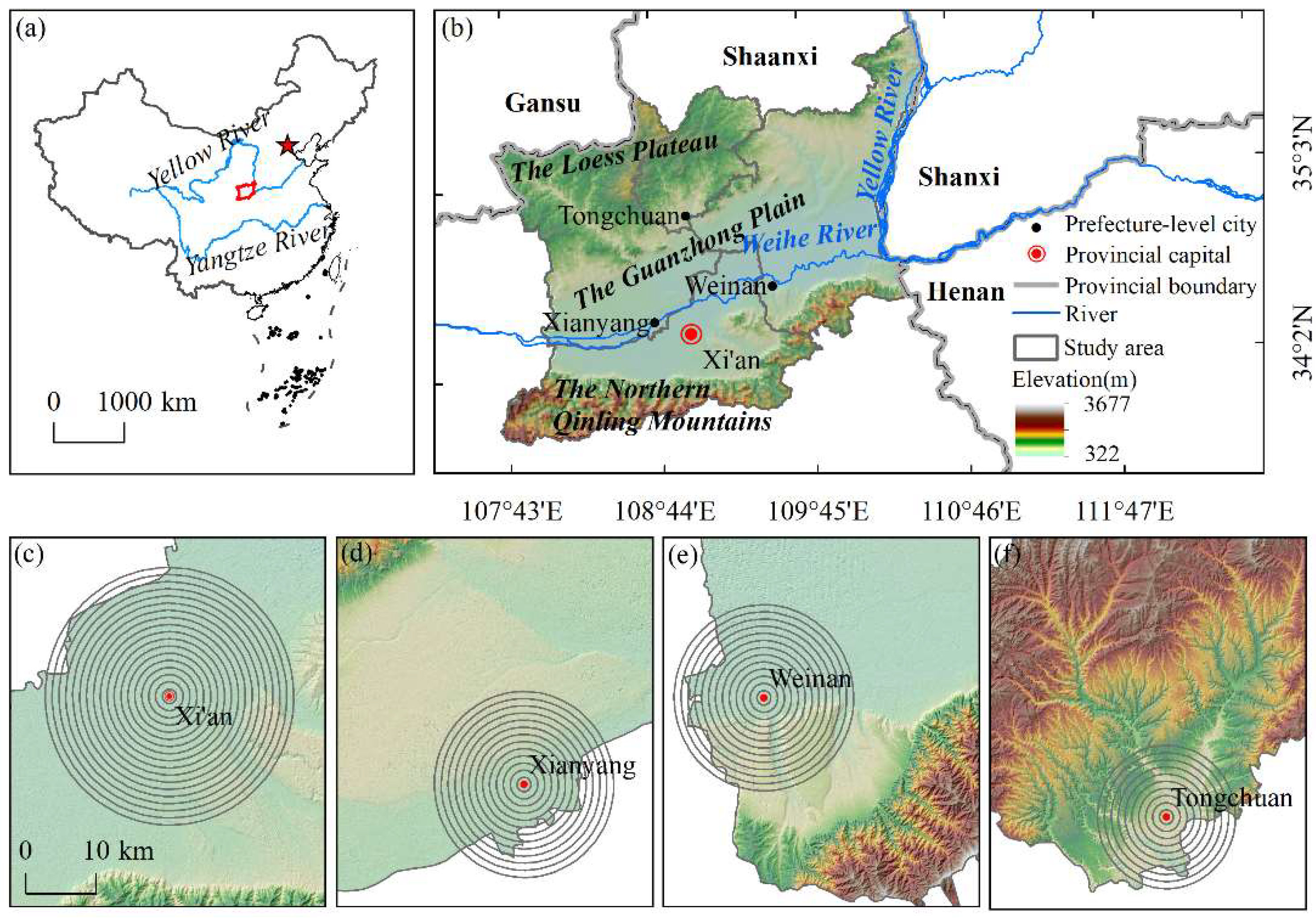
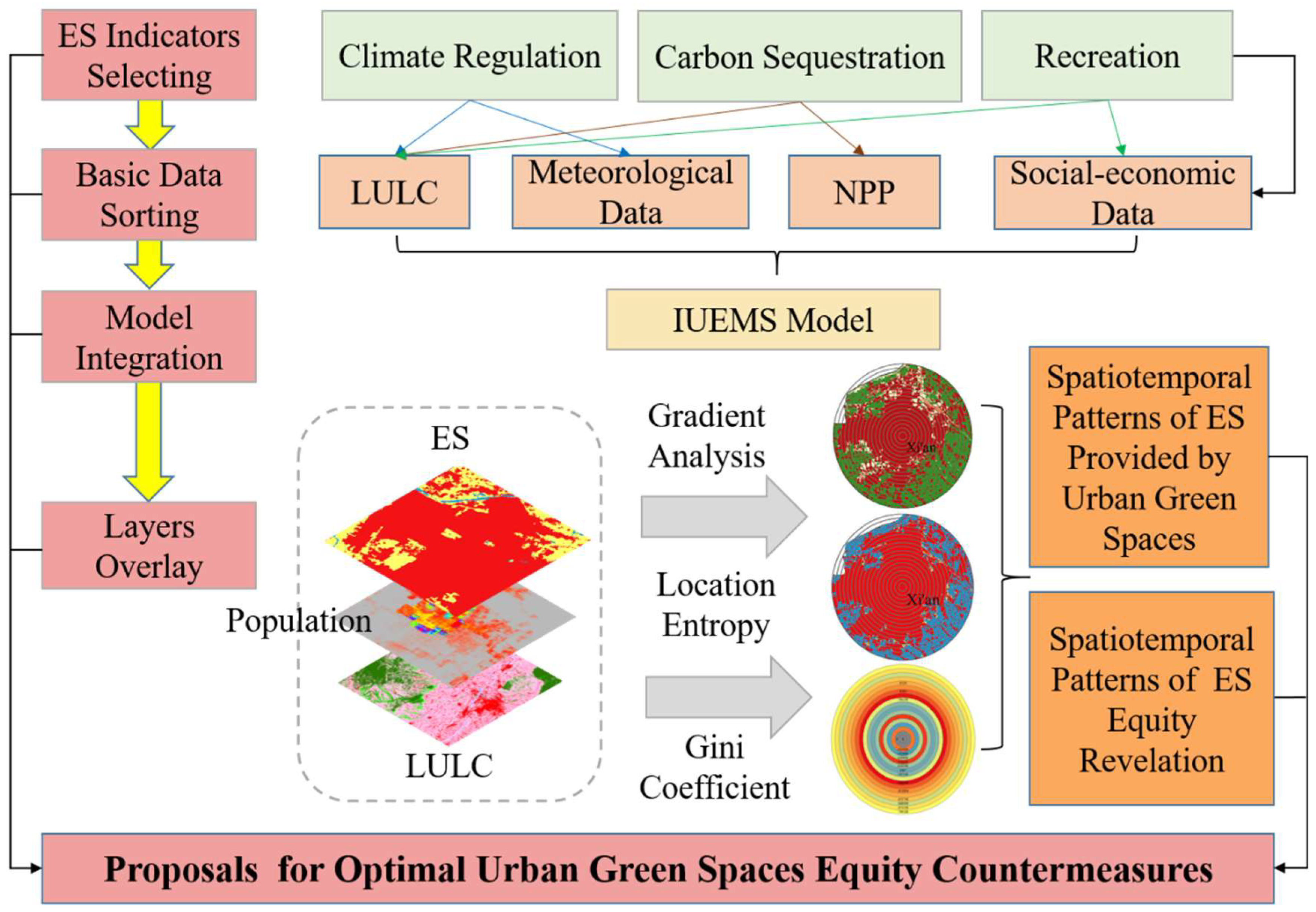
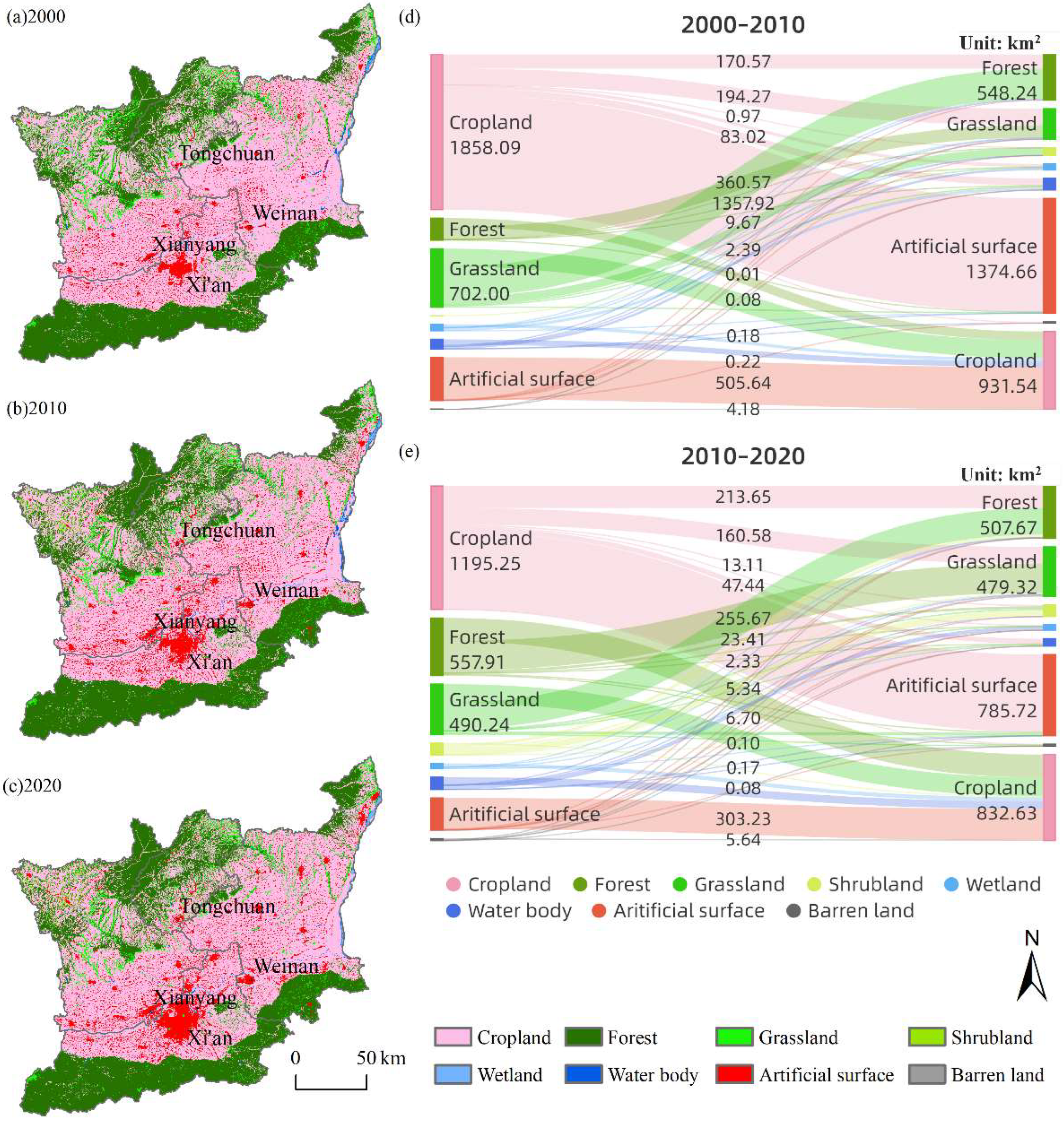

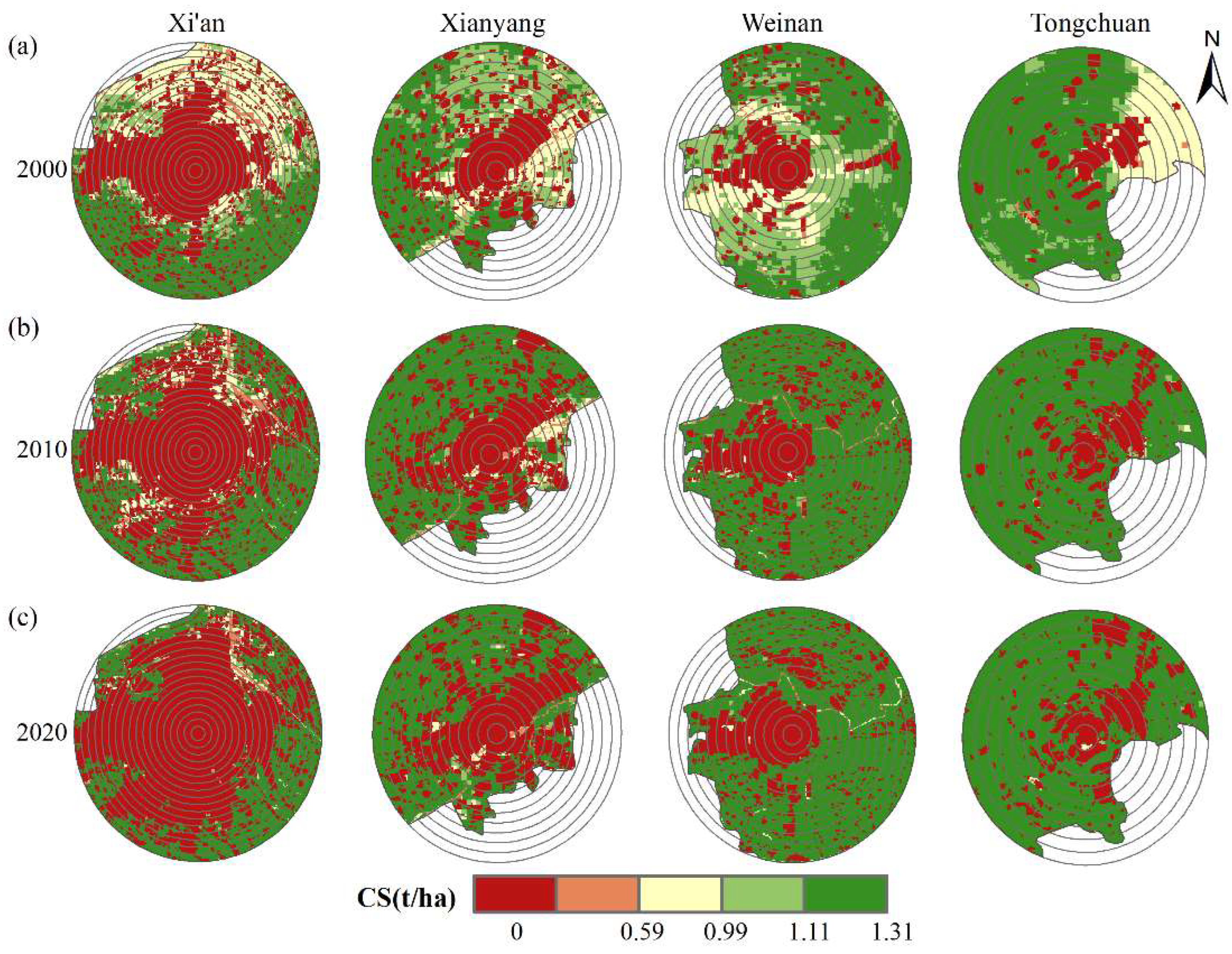
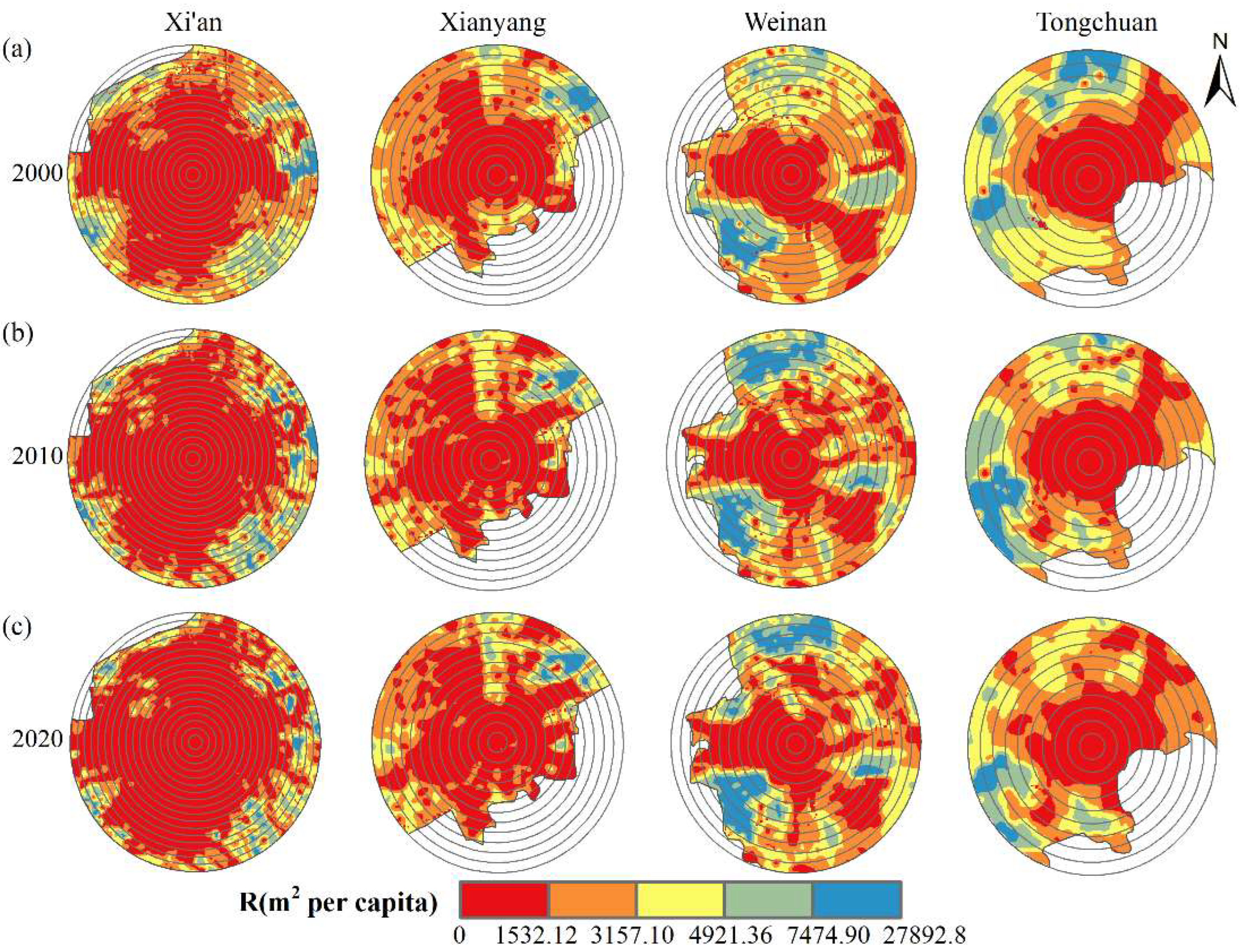
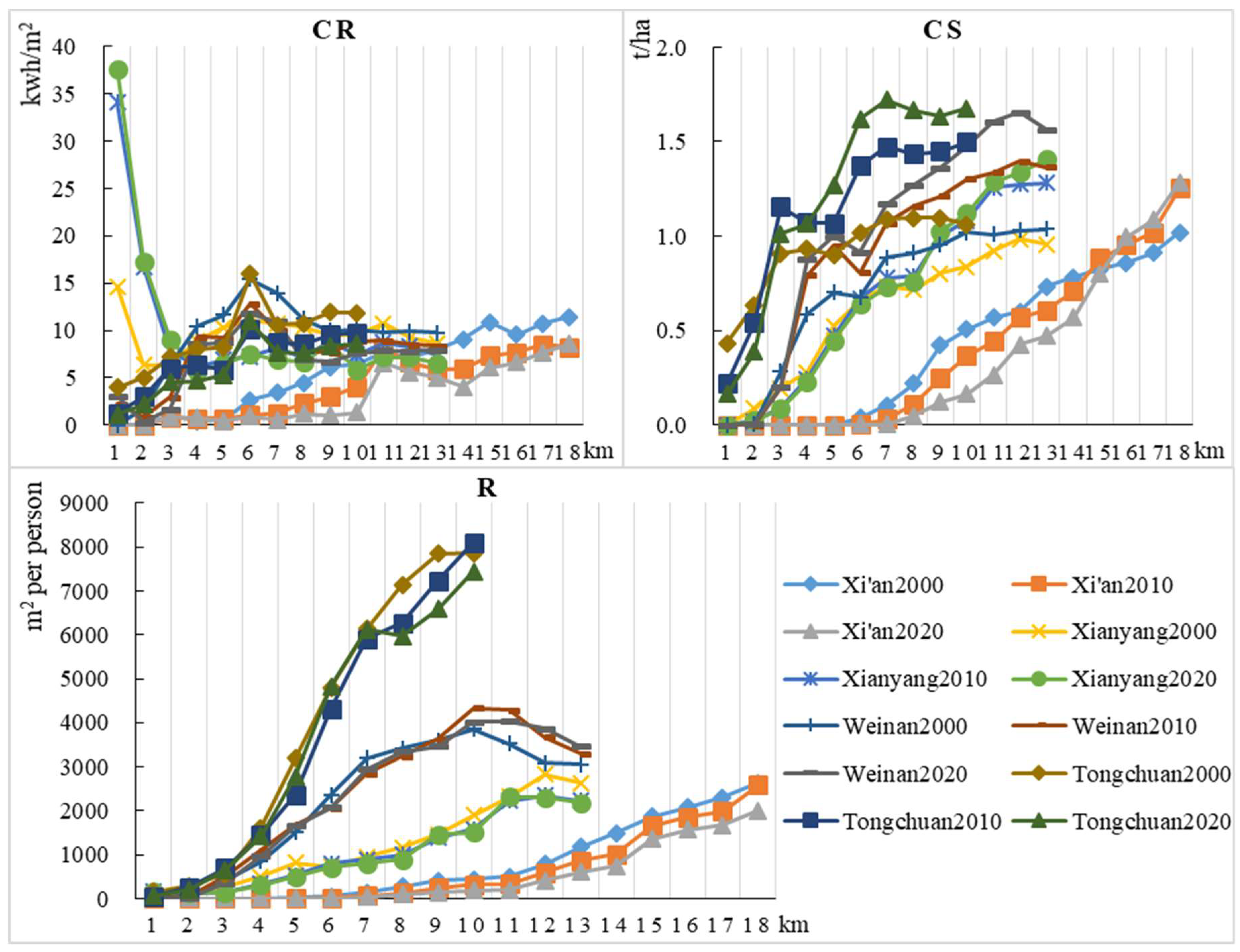
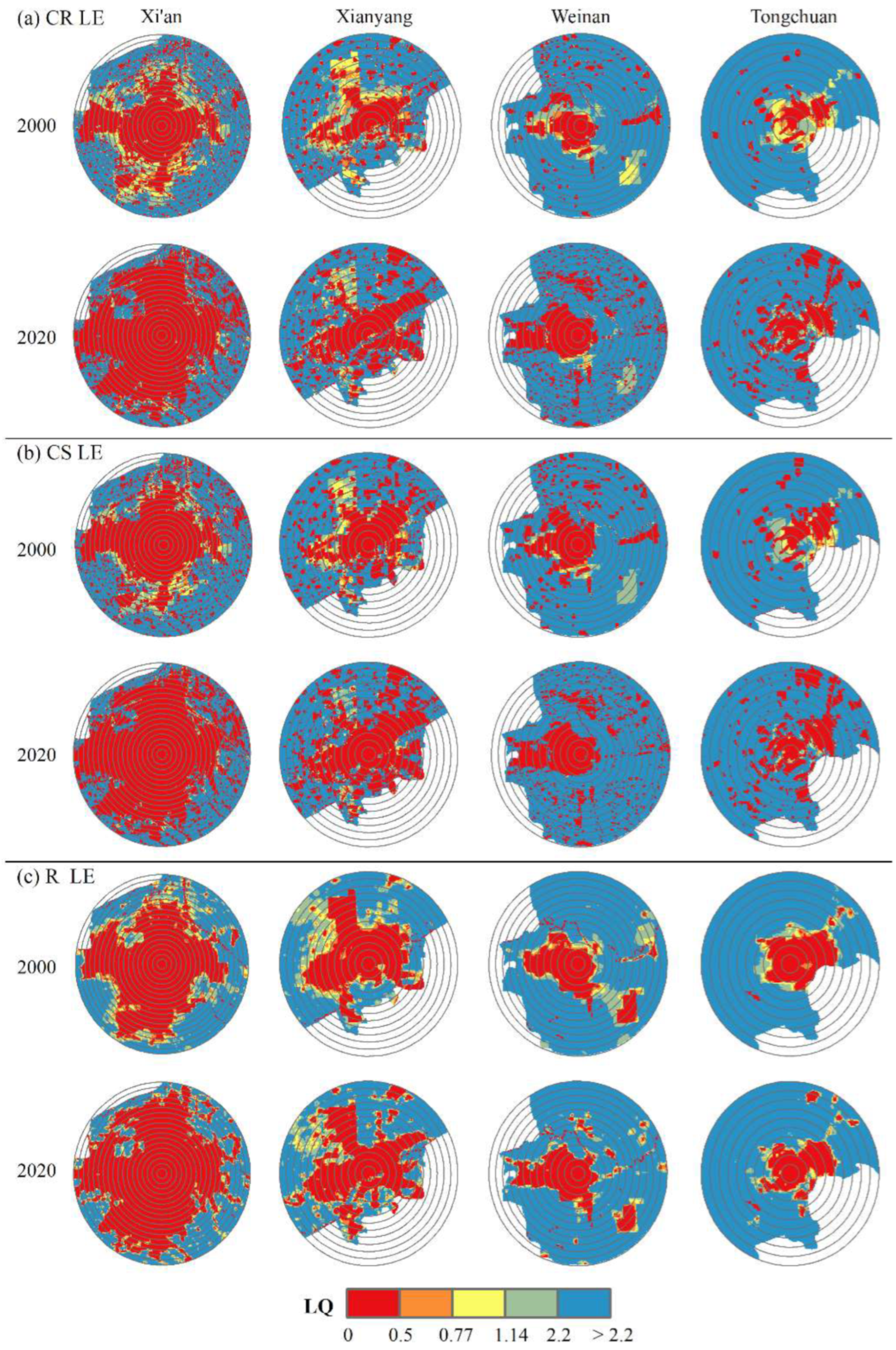


| Data | Time | Data Type | Data Source |
|---|---|---|---|
| LULC data | 2000, 2010, and 2020 | Raster (30 m) | http://www.globeland30.org/, accessed on 21 July 2021 |
| Population density data | 2000, 2010, and 2020 | Raster (100 m) | https://www.worldpop.org/, accessed on 16 August 2021 |
| Meteorological data | 2000, 2010, and 2020 | -- | http://data.cma.cn/data/, accessed on 26 July 2021 |
| Net primary productivity of vegetation data | 2000, 2010, and 2020 | Raster (100 m) | https://e4ftl01.cr.usgs.gov/, accessed on 12 August 2021 |
| ASTER DEM v3 | 2019 | Raster (30 m) | http://www.geodata.cn/, accessed on 28 July 2021 |
| Level | Value of Location Entropy | Remark |
|---|---|---|
| Extremely low | Lower than 0.5 | The ES provided by UGS level per capita is less than half of the average of the study area |
| Relatively low | 0.5 to 0.77 | |
| Moderate | 0.77 to 1.14 | |
| Relatively high | 1.14 to 2.2 | |
| Extremely high | Higher than 2.2 | The ES provided by UGS level per capita is more than two times higher than that of the study area |
Publisher’s Note: MDPI stays neutral with regard to jurisdictional claims in published maps and institutional affiliations. |
© 2022 by the authors. Licensee MDPI, Basel, Switzerland. This article is an open access article distributed under the terms and conditions of the Creative Commons Attribution (CC BY) license (https://creativecommons.org/licenses/by/4.0/).
Share and Cite
Peng, L.; Zhang, L.; Li, X.; Wang, P.; Zhao, W.; Wang, Z.; Jiao, L.; Wang, H. Spatio-Temporal Patterns of Ecosystem Services Provided by Urban Green Spaces and Their Equity along Urban–Rural Gradients in the Xi’an Metropolitan Area, China. Remote Sens. 2022, 14, 4299. https://doi.org/10.3390/rs14174299
Peng L, Zhang L, Li X, Wang P, Zhao W, Wang Z, Jiao L, Wang H. Spatio-Temporal Patterns of Ecosystem Services Provided by Urban Green Spaces and Their Equity along Urban–Rural Gradients in the Xi’an Metropolitan Area, China. Remote Sensing. 2022; 14(17):4299. https://doi.org/10.3390/rs14174299
Chicago/Turabian StylePeng, Lixian, Liwei Zhang, Xupu Li, Pengtao Wang, Wudong Zhao, Zhuangzhuang Wang, Lei Jiao, and Hao Wang. 2022. "Spatio-Temporal Patterns of Ecosystem Services Provided by Urban Green Spaces and Their Equity along Urban–Rural Gradients in the Xi’an Metropolitan Area, China" Remote Sensing 14, no. 17: 4299. https://doi.org/10.3390/rs14174299







